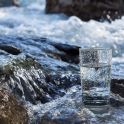
Radioactive materials in food: Researchers determine consumption levels of food groups of radiological interest
Radioactive materials can enter our bodies from the environment via respiration or food. According to the Federal Office for Radiation Protection (Bundesamt für Strahlenchutz, BfS), this so-called "internal radiation exposure" via food ("ingestion") leads to an annual radiation dose of 0.3 millisieverts. Knowledge about the radioactive materials in food and the consumption habits of the population is important in order to be able to estimate people's resulting radiation exposure.
How do radioactive materials get into food?
All food contains radioactive materials - so-called radionuclides. Radionuclides can be of natural origin (e.g. from soil, rock and air) or artificially produced by humans (e.g. fallout from nuclear weapons tests, nuclear reactor accidents, but also discharges or contaminated sites).
Research project on consumption studies: Determining the consumption quantities of radiologically interesting food groups
In a research project funded by the BfS, GRS has analysed the statistical data on consumption in Germany in relation to radiologically relevant food groups. To this end, GRS researchers first compiled all national consumption studies published since 2000.
As the consumption studies originally pursued objectives other than calculating the ingestion dose, the food groups and age groups in the studies were compiled according to other criteria. A key aspect of the GRS project was therefore to develop a concept for regrouping the food groups by breaking them down into around 800 different agricultural base units. To this end, the data from various consumption studies were processed in the same methodological way in close co-operation with the Federal Institute for Risk Assessment, the Max Rubner Institute, and the Robert Koch Institute.
The raw data from the studies were sorted according to the six age groups - from younger than one year to older than 17 years - and the ten food groups used in the current Radiation Protection Ordinance (StrlSchV).
The food groups include
- drinking water
- breast milk
- milk and dairy products
- fish
- meat
- cereals
- fruit and juice
- potatoes, root vegetables
- leafy vegetables
- vegetables
Another aim was to find out whether there are regional and gender-specific differences and whether long-term nutritional trends are emerging. Working with the data also involved checking the representativeness and uncertainties in the data.
The result of the research project is an updated table of the consumption levels of the German population, which can be used to calculate exposures due to ingestion. Further information on the project can be found on the website of the Federal Office for Radiation Protection.
Project highlights Radiation Protection

In the project, the GRS research team developed a central database for all information on water supply facilities in Germany that is relevant for radiation protection.